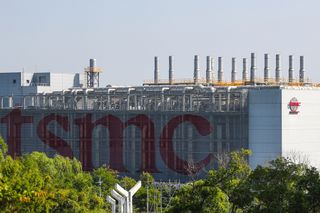IF a Big IF Huawei is able to produced its 3D stacking 14nm chips in 2022 and 7nm in 2023, then there is a chance that maybe in 2024, a Huawei or SMIC 5nm 3D (DUVL) chip will be able match TSMC who are having yield problem with its 3nm chips.
7 hours ago — A report citing semiconductor industry sources indicates that
TSMC reportedly has difficulty with its
3nm process yields
TSMC 3nm Yield Problems May Derail AMD's CPU Plans
By
published about 7 hours ago
Difficulties with the 3nm furnace
TSMC (Image credit: ToyW / Shutterstock.com)
A report citing semiconductor industry sources indicates that TSMC reportedly has difficulty with its 3nm process yields. Taiwan's
says that if the 3nm yield problem continues, many customers might extend their use of the 5nm process node. In addition, TSMC's struggles could impact the product roadmaps of the PC world's favorite names like AMD and Nvidia.
It's essential to take the report with a pinch of salt. The people in the know might be correct, but TSMC hasn't publicly admitted any N3 delays so far. On the contrary, it has asserted that it is "on track with good progress."
The source report's critical rumor is pinned upon TSMC, finding it very difficult to achieve satisfactory yields with its 3nm FinFET processes. It explains that TSMC has "continuously revised" its 3nm offerings, and the foundry is seemingly doing this to find a sweet spot for yields (the percentage of chips that are not faulty). The latest TSMC introduction is N3E, a lower-cost version of TSMC's 3nm manufacturing process, which surprised industry watchers by arriving a year after N3. TSMC also makes N3B processors for some customers, depending upon design and cost constraints. Despite TSMC's process wrangling, outlined above, and "constant revision," the insiders say yields continue to remain lower than expected.
Due to the 3nm family issues, some TSMC's customers are looking at rejigging plans, which means changing their roadmaps. In addition, customers like Apple and Intel have paid a lot to secure N3 process chips in the coming months. Other partners like AMD must not have felt the urgency or need for such lavish pre-payments so that they will feel the most substantial effect of TSMC's yield issues.
AMD's Roadmap Roadblock
The DigiTimes report says that AMD is one of the biggest customers of the TSMC 7nm family, which offers N7 and N6 process fabrication. AMD has just started to move parts to N6, such as the
series of processors for laptops. Newer GPUs will be coming out based on N6 output too.
AMD's subsequent big releases, such as the Ryzen 7000 series desktop processors and Genoa and Bergamo server processors, will all be based on the Zen 4 architecture and be fabricated at 5nm by TSMC. As a reminder, the TSMC 5nm process family will be referred to as N5 and N4 processes by TSMC. AMD had planned to go on to TSMC 3nm for Zen 5 and RDNA 4.
The report also mentioned Nvidia, saying that the green team was set to return to TSMC later this year and will use one of TSMC's 5nm processes for the RTX 40-series GPUs, having paid "billions of dollars" to secure this production allocation.
TSMC vs Samsung
The news outlet threw some interesting Samsung semiconductor business morsels into the article. While TSMC has various 3nm wrinkles to try and iron out, Samsung's progress is also rough, it asserts. Moreover, it comments that Samsung's recent 4nm Exynos 2200 debut wasn't the barnstormer it had teased.
Samsung has a significant hurdle to leap over with its upcoming 3nm process, too. The South Korean tech giant moves to the Gate-All-Around FET (GAA) transistor architecture. It's quite a change to make, but it should make advances later down the pipeline easier. However, its transition to 3nm will be all the more tricky before it can reap the rewards.

